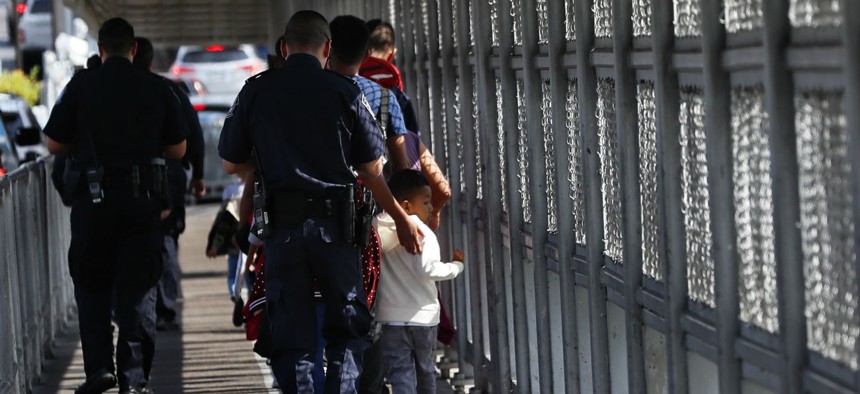
Customs and Border Protection officers escort migrants being taken to apply for asylum in the United States, on the International Bridge 1 in Nuevo Laredo, Mexico. Marco Ugarte / AP
Trump's Immigration Shakeups Continue to Cause Headaches for Homeland Security Workforce
Employees face a lack of training and a request to shift away from their day jobs.
Frequent changes in immigration policy are causing confusion and frustration among the employees carrying them out, according to officials at agencies tasked with implementing the reforms.
President Trump’s move to upend asylum laws, for example, has left officers at U.S. Citizenship and Immigration Services looking for new portfolios—or different jobs altogether—according to a union official representing those workers. The departments of Homeland Security and Justice announced this week the United States would deny—with limited exceptions—asylum to any migrant who entered a third country before reaching the U.S. border. Critics have panned the announcement as a violation of international treaties and U.S. law and the policy change has already led to a lawsuit from the American Civil Liberties Union, though the administration has defended the move as necessary to deal with an influx of migrants looking to exploit “loopholes” in the nation’s immigration policy.
“It’s beyond hurting morale,” said Michael Knowles, head of the American Federation of Government Employees council that represents USCIS in the Washington, D.C., area. “Employees are asking, ‘How can I stay in this job?’ ”
Knowles, himself an asylum officer, said many of his colleagues feel they are violating the law by carrying out their new orders.
“It places the officers in a horrible position,” Knowles said. “What do they do?” He added that some asylum officers have moved into other roles to handle immigration benefits, but USCIS has in recent months asked anyone throughout the agency with training in handling asylum cases to return to that line of work to address the surge in applicants.
Acting USCIS Director Ken Cuccinelli has criticized Knowles' union for standing in the way of necessary reforms.
The new rule has caused confusion for immigration judges who hear asylum cases in the Justice Department’s Executive Office of Immigration Review. Ashley Tabaddor, a judge based in Los Angeles and president of the National Association of Immigration Judges, said the fallout of the new policy for the 400 immigration review judges is still unclear and will depend on the legal proceedings still playing out. The Trump administration is fighting to overturn a court decision to block its plan to ban migrants who crossed into the U.S. illegally from requesting asylum. Another policy is forcing most asylum applicants to wait in Mexico while their claims are being processed.
“It is quite challenging to have to constantly be mindful of the moving target of policy decisions and changes that are inflicted on us,” Tabaddor said. “This is no exception.”
One asylum officer told Government Executive the workforce did not receive any guidance to implement the new policy until a day after it was announced publicly, and that officers are still awaiting promised training.
The new policy “is extraordinary,” the officer said. “It’s not just a little change in the process.”
USCIS management also seemed to express concern internally over the ad hoc nature of the policy rollout. John Lafferty, the head of asylum at USCIS voiced frustration with the repeated requests to rapidly change course, according to a memorandum obtained by the Los Angeles Times.
“We are once again being asked to adapt, and to do so with very little time to train and prepare,” Lafferty said, according to the Times. “If I didn’t know that we have some of the most dedicated, adaptable, and most talented public servants presently serving in the federal government, I would be concerned about being able to implement these changes on such short notice.”
Some USCIS officers will soon be dealing with another shift, as management has sent an agency-wide request looking for volunteers to detail out to Immigration and Customs Enforcement. Current conditions have strained ICE’s resources, according to USCIS, leading it to ask its employees to work in three areas: Enforcement and Removal Operations, the Office of the Principal Legal Advisor and the Office of Management Administration.
“There is a national emergency at our Southern border,” said Jessica Collins, a USCIS spokeswoman. “Because Congress refuses to provide the targeted changes needed to close the loopholes in our immigration laws, USCIS continues to partner with the Department of Homeland Security and our sister agencies to mitigate the crisis.”
She added that Congress could quickly address the situation by changing immigration laws and until it does, the government will continue to struggle to address the surge in migrants. BuzzFeed first reported the USCIS request for volunteers.
USCIS has already asked employees to volunteer to deploy to the border to assist in other border security roles this year. Customs and Border Protection previously reassigned 750 customs officers from ports of entry to assist Border Patrol staff and DHS subsequently sent out a departmentwide request for volunteers to go to the southern border.
“We always promote volunteers and we outperformed every other DHS component during the last hurricane,” Knowles said. “But we would be reluctant to see important programs like ours not be resourced when we’re facing our own crisis.”
As of fiscal 2018, USCIS maintained a total backlog for all immigration cases of nearly 5.7 million. That represented a 42% increase since three years earlier. The Government Accountability Office has agreed to investigate “several issues regarding the current backlog,” but will not begin that probe until the fall.







